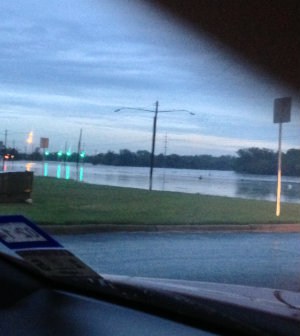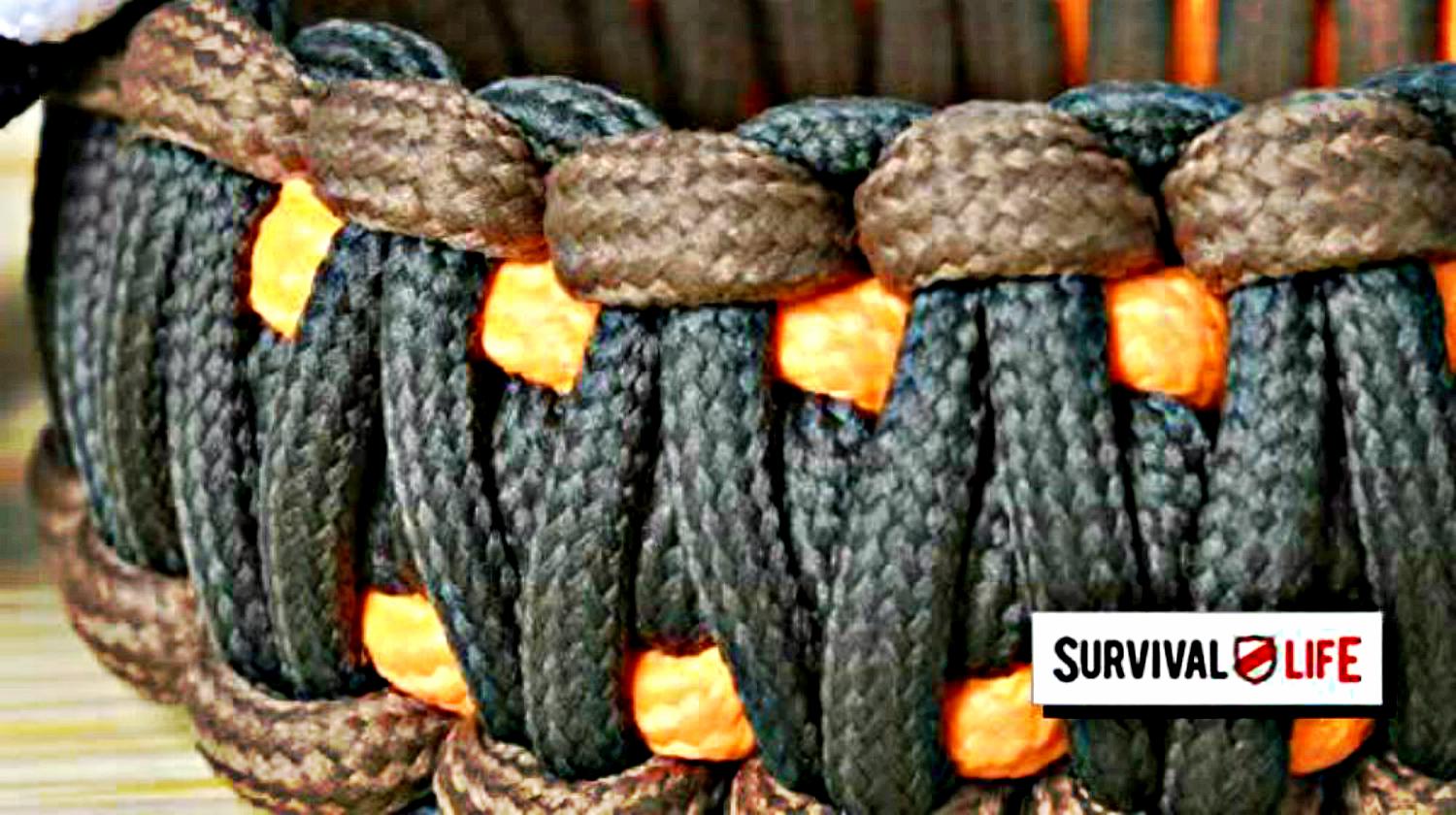Archives
It Never Rains, But It Pours… | Flood Survival

Many of you may already know this, but I live down in Austin Tx, and down here rain is a bit of a sight to see.
I always joke around saying that I will take all of the rain I can get.
But I never meant for it to be all at once…
Take a look at the image to the right.
(Sorry for the rough quality, but it was a rough morning.)
I snapped this from my phone, less than 1000 yards from my front door.
It may be a little hard to see but the water level is only about 4 feet from the bottom of the stop lights.
Over the course of only a few hours, we had well over a foot of rain come pouring down.
And I, as it happens most times when it rains, slept like a log, none the wiser of just how close I came to being the proud owner of a water bed…
It took a couple of days for the water to subside, and for us to really see the damage.
Lives were lost, homes were destroyed and cleanup is still underway.
If this were to happen to you, how prepared would you be?
Fellow Austinite, and writer Jeff Kubiszyn saw much of the same devastation that I did and he wanted to share a few tips with you about flood safety:
Halloween proved to be more of a trick than a treat for many families in Central Texas. Early morning rains turned creeks into raging rivers, which flooded neighborhoods and left residents scrambling on to their roofs for safety. For many residents, there was no warning. The Austin neighborhood of Onion Creek was one of the hardest hit. So much rain fell that the creek quickly left its banks and flooded the neighborhood. People woke to find water in their homes. Cars floated down streets.
Trapped in their homes, people sought refuge in attics or on top of roofs. Those with cell phones called for help. Rescuers plucked people off their roofs by boat and helicopter. Rescue operations went well into the day on Halloween. Family members waited desperately to get news on loved ones. Fortunately there was no loss of life. This was not the case in other Central Texas communities. In all, five people perished as a result of flooding in the area.
The weather can be unpredictable and become life-threatening in an instant. Improve your chances of surviving by creating a action plan. Keep in mind you may only have minutes to leave your home. Here are a few simple steps to include in your plan.
- Stay informed. Follow the weather forecast. Even though the weather can change in an instant, today’s forecasting technology gives us a pretty good idea of what to expect. This will help you develop a action plan. Purchase a NOAA weather radio.
- Plan your escape route in advance. How can you get out of the path of Mother Nature? Do you have multiple escape routes identified? Will these escape routes lead you away from, or back into danger? Understanding which way to flee may seem trivial, but in a chaotic situation you won’t have time to plan alternate routes. Leave early if possible. Remember that others will be trying to evacuate the area as well.
- Know where you are going. Where do you plan to ride out the storm? A family member’s home? The mall? A hotel? Make sure your place of refuge isn’t in the path of destruction or difficult to get to.
- Have a full tank of gas in your vehicle. Stopping at a gas station while an F4 tornado is barreling down on you is not advisable. Fill up in advance of approaching weather.
- Make sure your cell phone is charged. A dead cell phone is useless if you become lost or stranded.
- Pack a bag with survival essentials. If you must evacuate your home, have a bag ready with items you will need to survive. This should contain:
- Medications
- Spare glasses (you won’t have time to put your contacts in)
- Wallet containing your ID, cash and a credit card
- Flashlight
- Fully charged cell phone
- Car keys
- Have your escape pack or “bug out bag” close at hand. You should be able to grab it and go.
- Have your escape clothes already laid out. The time spent selecting an outfit could cost you your life.
- Pets. Factor in how to safely transport your pets. What pet supplies do you need to bring?
- Call someone and let them know what your escape plan is. Let a friend or family member know where you plan to go and that you will check in with them when you get there. This way, if you don’t make it to your final destination (or fail to check in), they can alert the authorities.
The 2013 Halloween floods are a reminder that Mother Nature is unpredictable. We are at her mercy. The best chance we give ourselves is to be prepared to act when the time comes. Preparedness can mean the difference between surviving a catastrophe, or becoming a statistic.
What other precautions can people take to better prepare themselves for a natural disaster?
Click here to view the original article and more from Jeff.
VIDEO: Flood Survival Tips
What Is The Real Cost Of Flooding?
Flood Survival Tips | How to Survive Natural Disasters
-

 Paracord Projects1 year ago
Paracord Projects1 year agoParacord Projects | 36 Cool Paracord Ideas For Your Paracord Survival Projects
-

 Paracord Projects1 year ago
Paracord Projects1 year agoHow To Make Paracord Survival Bracelets | DIY Survival Prepping
-

 Medical Care1 year ago
Medical Care1 year ago21 Home Remedies For Toothache Pain Relief
-

 Knife Laws1 year ago
Knife Laws1 year agoAre Switchblades Legal? Knife Laws By State
-

 Do It Yourself1 year ago
Do It Yourself1 year agoSurvival DIY: How To Melt Aluminum Cans For Casting














Gary
November 11, 2013 at 12:00 PM
water is not even up to the curb in the foreground. Being in Houston where the streets flood if a dog pees, thats normal. Raining faster than the drainage can handle it causes the flooding. Two hours later and its all gone.
dodger
November 11, 2013 at 12:20 PM
Other than city & state officials declaring disaster areas and FEMA assessing the damages, we don’t hear much about this disaster, unlike hurricanes Katrina & Sandy (for example). No news clips of people begging for the Feds to come help them, crying that they’re starving or have no drinkable water, not that those affected don’t need and appreciate all the help they can get! No shots of looters carrying TV’s or shopping carts full of boxes of athletic shoes out of stores. No stories of police/sheriff’s depts. confiscating guns from law abiding citizens. Why? What’s the difference? I can tell you in two words: self reliance! It’s being mentally ready to take care of whatever obstacles may block your path in life. This is the way most citizens of this country USED to think, but the “Nanny State” mentality threatens to overwhelm our natural self-reliance.
Lee
November 11, 2013 at 1:07 PM
Having been through Katrina may I offer that you not only have an escape route ready but a viable destination, practice your escape route in heavy traffic and inclement weather and have an alternate destination in case the primary one is not attainable.
Many people evacuating the various hurricanes in the New Orleans area have found that in the evac traffic they’ve taken eight hours to go a bit better than a mile. This results in cars stalling out and running out of gas, further increasing delays and making reaching your planned destination, if it’s close to a tank full of gas.
Realize that many cities will not be hospitable to you as some Katrina evacuees found out. Some of the smaller cities within about 75 miles of New Orleans closed off interstate exits to prevent evacuees from camping in their parking lots and on city streets. You can bet that from what these cities learned during Katrina the controls will be even tighter next evacuation so don’t automatically count on nearby cities welcoming you with open arms unless you have a place to stay already lined up.
Also check with the State Police regarding how they are going to handle evacuation traffic. The routes on the interstates have contra-flow traffic meaning that both the incoming and outbound lanes will be all outgoing. Also, the Mississippi State Police blocked the I-10 to east-bound traffic, rerouting all of the evacuees that wanted to go east unexpectedly on to north and west-bound roads, leaving their plans high and dry and increasing the delays. It would be in your best interests to check and see if the State/local Police in any area you are planning on driving through have plans to reroute traffic and, if so, to where.
Find a safe way to carry spare gas – there were a lot of dead cars parked by gas stations displaying ‘No Gas’ signs. Normal gas use rates went sky high as evacuees used more gas in idling through heavy traffic than they’d planned on. No one’s going to come to your aid any time soon as they have larger problems, so if you don’t have enough gas make sure you have enough supplies in your vehicle, readily at hand, to last for a while – I carried a 3-day emergency water/survival food supply in the truck right on top of the back seat. Don’t forget potty supplies too.
Find that alternative way to your both primary and alternative destinations just-in-case. Drive them until you are familiar, also noting places for things such as water just in case you need it, Streams, creeks – mark ’em all on a strip map just in case the GPS unit fails. I saw people with overheated cars retying to figure out how/where to get water and no one was going to pull out of traffic to help them. Drive those alternate ways TO your destinations, remember they’ll look different driving TO them if you just drive BACK from them and try to keep up via internet on things that will effect their use such as construction. What you learn ahead of time you won’t have to learn in an emergency.
Unless you have friends or a place guaranteed to take you in count on going a long distance. During Katrina it was hard to find an open room as far west as Houston and as far north as Birmingham. Also, in case of an emergency do not count on that hotel/motel reservation you made staying open – a lot of people found the rooms they’d been guaranteed were sold to higher bidders as it was a ‘state of emergency’. I carry a small tent and clothing appropriate to the climate I’m expecting in a separate bag.
Those cardboard-tasting energy bars come in handy, especially if you’re stuck in traffic for hours at a time or in a town where evacuees have already consumed the available food from restaurants and diners. That portable personal-sized water filtration/purification unit’s handy too as you may have to stop and rehydrate from one of those water sources you’ve hopefully previously located and marked on that strip map. I had to use mine a few times during Katrina and the few bucks extra I paid for a quality unit paid off when I looked at what I was going to be purifying and drinking – it was DAYS before FEMA or the Red Cross got water to us – think how long it will be for you if you aren’t in a major urban area.
I’ll close with ‘don’t depend on your cell phone’ as from personal experience I can tell you that the increased cell traffic during a major panic leads to a lot of dropped calls and ‘sorry, system’s overloaded’ messages. If the power goes out to the cell towers they can run on backup batteries and/or generators but not forever. Until the cell providers brought portable units into the city we were almost totally devoid of cell traffic towards later during the flooding. Get as much vital information to intended recipients as you can before you have to fight the increased traffic. CB is nice too, it will be jammed but at least you can receive some degree of information about what’s going on around you. And that hand-held emergency weather radio should be close-by too.
Pingback: Flood Survival Tips | How to Survive Natural Disasters